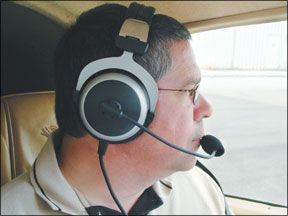With the exception of GPS, hardly any segment of the GA gadget and accessories market lacks for competition. Thats especially true of headsets, where there are dozens of models to pick from in both active and passive noise reduction designs. There are so many, in fact, that its impractical to test them all. So for this article, we picked seven popular passive headsets and wrung them out, both in the audio laboratory and in an impartial, focus-group aircraft test. Interestingly, our lab findings and inflight results diverged dramatically on some of the headsets. It turns out that just because a headset has good lab numbers doesnt mean its a go-to model in the airplane. Comfort and perceived audio quality can and should rule the decision. As we did for our extensive ANR headset tests reported in the May 2007 issue, we subjected each headset to a battery of sophisticated audio testing. We were able to use the engineering facilities of Plantronics, Inc., a worldwide leader in telecommunications headsets. To design and perform these tests, we worked with senior product engineer Nirmala Ganapathy, technical associates Dan Sellings and Robert Cuneo and senior technician Tom Trumbell. We were assured impartiality by our own participation in the testing. Plus, although Plantronics does make aviation headsets, they don’t make any of the type tested here. Gulf Coast Avionics (http://www.gulfcoastavionics.com/) loaned us one each of the headsets and, at our request, participated in the focus-group testing. Prices given here are GCAs discounted prices, which are similar to other mail order houses.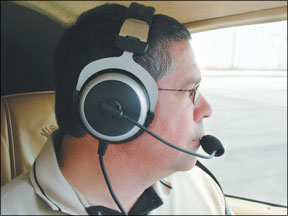
How We Tested
Each headset was tested across a range of qualities summarized on page 16. For the earphone tests, each ear was tested separately and the results were averaged
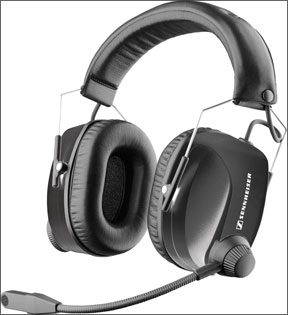
228
on the David Clark, the Gulf Coast 4T and the Sennheiser. On the Flightcom, LightSPEED and Telex, one ear performed markedly worse than the other, making us suspect some defects, but further investigation revealed no flaws in either our testing or the headsets, so we used results from the better of the two earphones.
We tested frequency response of all the earphones and microphones according to the limits of the headset TSO. Most of the earphones tended toward reduced low-frequency response and elevated high-frequency response. Microphone response was uniformly excellent for all of the headsets. The results from all the microphones were so close, in fact, that we suspect that many of the manufacturers use the same microphone supplier.
Effective communications can tolerate distortion levels up to a few percent, although lower is certainly better. There was a wide range of performance in earphone distortion. But the chart doesnt tell the whole story. (More on that later.)
Remember using two cans and a string when you were a kid? Sound vibrations can be coupled mechanically more effectively than they can through the air. Thus, its possible to couple sound from the earphone to the mic. As isolation of -55 dB is about the threshold of detection but performance of -60 is better, while -50 and closer to zero would be worse. The headsets generally performed we’ll with only the LightSPEED disappointing in this regard. Its worst crosstalk value was -38 dBV and we suspect that only in very specific conditions might this be noticeable.
Most properly designed microphones reject sound not originating from directly in front. This is crucial in a noisy cockpit. Testing of mic noise cancellation requires a complex battery of tests and an equally complex mathematical reduction of that data into something meaningful. Plantronics principle acoustic engineer Steve Graham designed a single-pass test we were allowed to use. Due to the proprietary nature of this test and the data it produces, we were asked to quantify the results and weve done this in the table.
Passive headsets are most effective at rejecting higher frequency external noise. We measured how effective the ear seal is in keeping out those higher frequencies. In our article on active headsets, complex psychoacoustic effects made translating measured performance into something meaningful all but impossible. We addressed this by qualitatively rating the level of noise reduction, as explained in detail on the sidebar on page 19. We followed the same strategy for the passive headsets. Furthermore, the test fixtures we used are bald and a disruption of the ear seal by strands of hair may cause a significant difference between measured and observed performance, as could a small or large or odd-shaped head.
What follows is a summary of each headset tested. Note that one of the seven headsets described here, the Beyerdynamics HS 300, wasnt available at the time we conducted our lab testing last winter. We did include it in our airborne tests, however.
David Clark H10-13.4
Counting helicopter variants, David Clark has the largest selection of passive headsets of any company we know of. Clark all but invented the notion of headsets for GA pilots and its products continue to be strong sellers. The H10-13.4 is a lightweight passive headset with gel earseals, a universal flexible mic boom and a single volume control on the mic side earcup. At 15.7 ounces, its in the middle of the weight range.
Performance- wise, speaker response sloped up from low to high frequencies more than average, with a total range about 10 dB. This wasnt as significant as the Telex, but it was noticeable from the graphs. It also had about a 5 dB dip at 2KHz, but was otherwise smooth. The two earphones tracked each other reasonably well. Earphone distortion was excellent and mic distortion proved the best overall. Noise cancellation of the mic was excellent combined with fair passive earphone noise isolation.
Technically, this headset all but aced the lab test and it did we’ll in the airplane, too, earning its place as our top pick in comfort and audio clarity. Clearly, Clark is overcoming its reputation for building headache-inducing noggin vises.
Flightcom Classic 4DLX
Flightcom plies the lower end of the market with the 4DLX, in both an airplane and helo version. At $99 discounted, its one of the least expensive headsets on the market. It has a combined liquid/foam earseal design with cloth covers and a hybrid
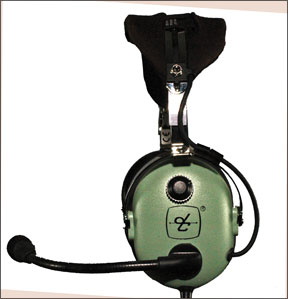
241
wire/flex boom mic design. Each earcup has its own volume control. It proved the heaviest of all the headsets in this group.
Our tests revealed great variation in the performance between the two ears. On one ear, the speaker response was smooth and regular and was nearly flat below about 1500 Hz and ramped up about 18dB at 3000 Hz, likely making it sound bright. (In-airplane testing confirmed this.) The other ear was quite irregular with an overall performance that spanned more than 40dB between 300 and 3000 Hz, possibly due to a defective speaker. Distortion on the one good ear was excellent while the mic distortion overall was second best. The mic had excellent noise cancellation, on par with the David Clark, but the passive noise isolation was the worst of the batch and our focus group confirmed this.
Gulf Coast Avionics 4T
In exchange for providing headsets, Gulf Coast asked us to test its house brand bargain product, the GCA 4T which, at $89, is one of the least expensive headsets on the market. Its made for GCA by Pilot. Its best described as an early Clark clone, with a single volume control, liquid earseals and a wire bail-type mic boom. At 14.1 ounces, its relatively light, but perceived clamping force is quite high.
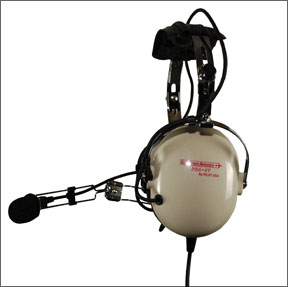
230
Quite to our surprise, this headset performed impressively. Earphone frequency response of this budget headset was among the best and this translated to the best perceived audio quality in the airplane of any of the headsets. Earphone response was essentially flat below about 1200 Hz and smoothly ramped to a peak of about 13dB at 3000 Hz. Both ears tracked almost identically. Earphone distortion was also good, peaking at the lowest frequencies. While most of the other headsets exhibited rising distortion levels at the higher frequencies, the 4T performed very we’ll at higher frequencies and only suffered below 300 Hz, not normally a concern in telecommunications.
Although the frequency response performance of the mic was typical, its distortion level was the worst we saw-enough to probably be noticed by a careful observer. The mic noise cancellation was good, typical of most of the headsets, while its passive earphone noise isolation was excellent. Comfort-wise, the 4T suffered due to its high clamping force.
LightSPEED QFR SSc
LightSPEED dominates the ANR market with a selection of mid-priced but good performing headsets. In the passive segment, the company has a couple of bargain-priced entries, with the $155 QFR SSc being the more expensive of the two. Like the ANR models, it has Confor foam earseals and a well-padded headband, with a flex boom for the mic and dual volume on an inline slider control. (We prefer knobs on the earcups, thanks.)
The mic exhibited the flattest frequency response overall, superior enough to be noticeable in the data but not necessarily in the airplane. Like the Flightcom, there was a significant difference between the earphones, with one showing enhanced
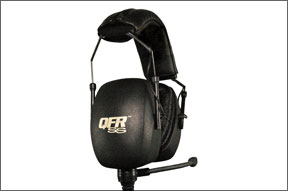
250
lower frequencies and a mid-frequency spike and very irregular performance overall with spikes and dips exceeding 15dB peak-to-peak. The other ear performed well. It had good, smooth response and didnt exhibit the typical up-slope with frequency rise that the others did. Even after ruling out the misbehaving ear, we were disappointed in the distortion levels of this headset, although the peak of over 9 percent was at lower frequencies. The lab trials suggested this distortion would be noticeable in a side-by-side comparison in the airplane and it was. The LightSPEED finished third behind the Clark and Telex in the airplane trials.
Sennheiser HME 110
We occasionally encounter companies we cant quite figure out. Sennheiser is one of these. The company has quite a selection of aviation headsets, both ANR and passive, but it doesnt seem to promote as hard as, say Bose or LightSPEED. Weve found Sennhesiers products to be competent, but not exceptional. And thats how we would describe the HME 110 passive model we tried.
At $268, its toward the top in the price stratum and although Sennheiser clearly pays attention to the audio technical details, real world performance is less impressive, in our view. Earphone response was typical, showing smooth performance throughout. It was essentially flat below 1000 Hz and ramped smoothly to a peak of about 14dB about 2000 Hz, above which it leveled off. Although not identical, each side tracked quite we’ll with the other; all good stuff.
The Sennheiser ranked second-best in earphone distortion. Mic distortion was typical (low) as was the ear-mic crosstalk performance. Both the mic and the passive earphone isolation were good performers. However, in the airplane, we noted a poor seal at the back of the earcups, yielding mediocre noise attenuation and muddy, soft-edged audio that made the radio and intercom difficult to understand. With numbers this good in the lab, we think Sennheiser should work on the mechanicals.
Telex Echelon 25XT
Along with David Clark, Telex has been in the aviation headset business for what seems like centuries. It makes a half dozen ANR and passive models, with the $299 Echelon 25XT being the more expensive of its two circumaural models. As with the companys ANR, the 25XT is bulky if not heavy. It has thick foam earseals and headpad and individual volume controls. The mic is on a universal flex boom and is easy to adjust.
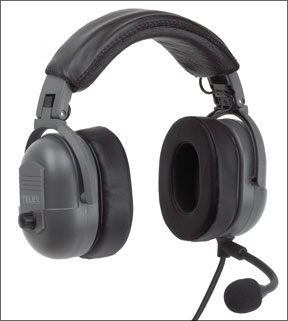
247
Technically, the 25XT is not exceptional. Speaker response was reasonably smooth, but one ear ramped up significantly with frequency. The other ear performed better, showing nearly flat response below about 1600 Hz and rising about 8dB above that up to a peak about 2600 Hz.
Like the LightSPEED, even ruling out the bad earphone couldnt help the poor distortion figures from the good ear. The peak distortion of 15 percent occurred right at 1000 Hz, where it will have the most impact. Mic distortion lived down to the performance of the rest of the headset, with the peak again occurring in the speech range. Only the GCA was worse. Noise cancellation in the mic was good while the passive rejection of the earphones was excellent.
In the airplane, it was a different story. The distortion may have been noticeable in an echoey audio quality, but even at that, the generous pads sealed well-especially around glasses-and yielded high marks in audio quality from our testers. Furthermore, clamping pressure was light enough to yield good comfort.
Beyerdyamic HS 300
Beyerdynamic seems to live in parallel universe with Sennheiser. Both are German companies plying the high-end and professional audio trade with a sideline in aviation headsets. It makes but two models, the HS 600 ANR and the HS 300 passive model that we tried which, at $299, shares the top price point with the Telex 25XT. The HS 300 wasnt available for our lab testing, but we did toss it into our focus group fray.
Unique to the HS 300 are large, perfectly circular circumaural earcups with leatherette earseals and a flex boom mic. Volume control is a single knob on a large and, in our view, awkward audio box that has one other unique attribute: This is the only passive headset to require batteries, which power the audio/cellphone interface.
This headset proved nothing special in our trials. Its round earcups don’t seal we’ll and three of our four testers found fault with the clunky battery box. Audio rated fair to good, but not as good as David Clark. Overall, the Beyerdyamic finished fourth, ahead of the Sennheiser.
Conclusion
Clearly, good technical performance in the lab shouldnt be the sole determinant in headset selection. But the lab results tell us where and how the manufacturers are paying attention to the audio fine points, while the flying tells us what they know about comfort, fit and ergonomics.
In this group of headsets, only David Clark got it all right, in our view, with careful attention to audio qualities combined with a mechanically robust and comfortable headset. So the H10-13.4 is our top choice.
Based purely on the numbers, the Sennheiser would be nearly as good. Unfortunately, unlike Clark, we think Sennheiser hasnt gotten the ergos just right, especially with regard to the all-important earseal. Therefore, we pick the Telex 25XT as our second choice. Despite its mediocre lab showing, it was comfortable and had good perceived audio quality in the aircraft trials. The surprise best value (for a non-pilot seat) was the GCA 4T. For only $89, it had the best perceived audio quality bar none and its noise rejection was excellent. Unfortunately, this came at the expense of high clamping pressure, leading us to conclude that its not suitable for a wear-it-all-the-time pilot seat, but would be a good choice for occasional use for a passenger.
Last, we’ll again advise you to buy from a vendor with a generous, no-questions-asked return policy. We found significant differences in these headsets related to head size, hearing acuity and personal preferences. If you can buy and try, you’ll know what works best for you.
Frank Bowlin is a regular contributor to
Aviation Consumer.
